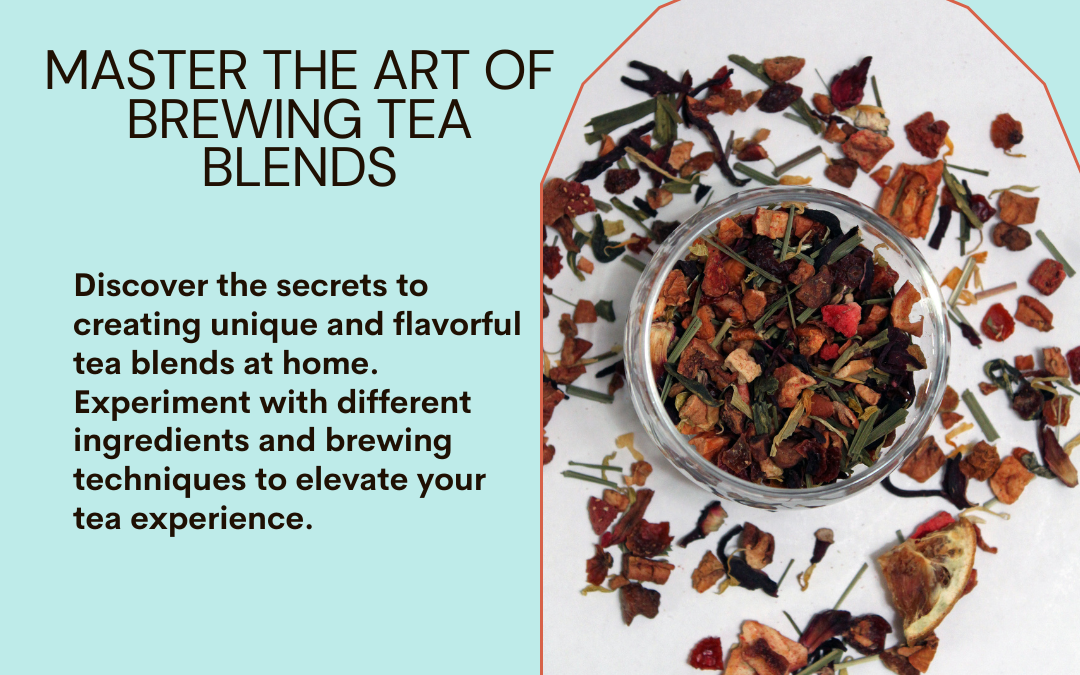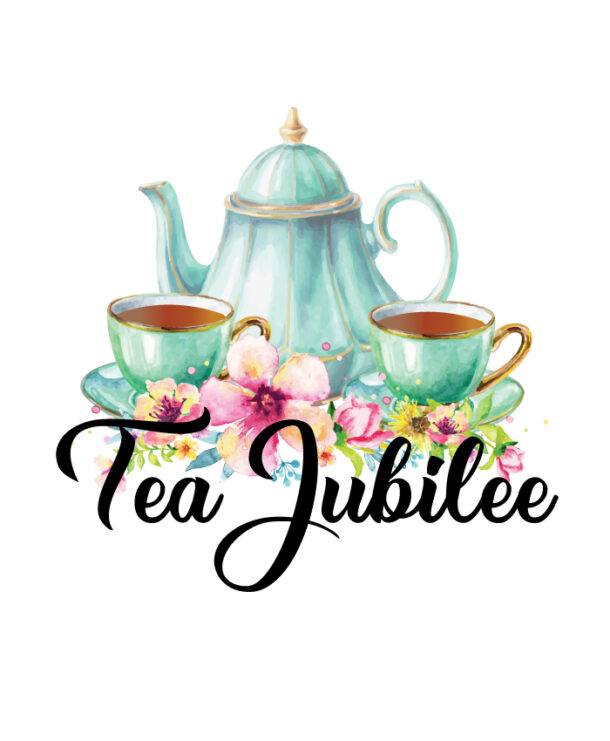==================
A Caveat and Affiliates
First off, a little caveat: within my articles you will find affiliate links, meaning if you buy them, I get a small commission. Your cost is not affected. In addition, I am an Amazon Associate and I earn from qualifying purchases on Amazon.
And yes, if I say that I recommend a product here, it means I truly believe it is a good product. I refuse to recommend any product that I have not researched and believe to be a good value.
Even better, I provide you with a very clear picture of the product, it’s use, and the probable value.
Earning your trust is important to me. I run this website myself and the commissions and donations help support the site.
Sound reasonable and fair enough? Let’s continue to the article.
==================
Contents
The Art of Brewing Tea Blends: A Step-by-Step Guide
Welcome back to Tea Jubilee’s series, all about The Art of Brewing Tea Blends, or what I call it, to make it simple, Tea Blending. Today, I have made this post about how you can make tea blends right at home, and I have a recipe in this post, too.
Are you ready to learn more? Then let’s keep learning as we read and understand The Art of Brewing Tea Blends.
Introduction to the art of brewing and savoring tea blends
Tea, a beverage cherished by millions worldwide, has a rich history and cultural significance spanning centuries. From its origins in ancient China to its widespread popularity today, tea has become more than just a drink—it is an art form. I will take you through brewing and savoring exquisite tea blends in this step-by-step guide.
Whether a tea connoisseur or a novice, this guide will provide the knowledge and techniques to elevate your tea-drinking experience to new heights.
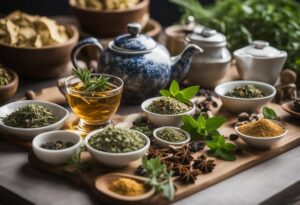
The history and cultural significance of tea
Tea has a fascinating history that dates back over 5,000 years. Legend has it that tea was accidentally discovered when Emperor Shen Nong of China was boiling water, and a tea leaf fell into his pot. Intrigued by the aroma and taste, he began cultivating tea plants, and thus, the tradition of tea drinking was born. From China, tea spread to other parts of Asia and eventually to the rest of the world. Today, tea is deeply ingrained in the cultures of many countries, each with its unique tea traditions and ceremonies.
Different types of tea and their characteristics
Tea comes in many different varieties, each with distinct characteristics and flavor profiles. The four main types of tea are black, green, oolong, and white. Black tea is fully oxidized and has a robust and bold flavor.
Green tea is unoxidized and has a fresh and grassy taste. Oolong tea is partially oxidized and has a complex and floral flavor.
White tea is the least processed and has a delicate and subtle taste. Within each type of tea, there are countless blends and flavors to explore, making the world of tea a vast and exciting one.
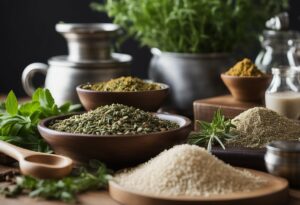
Understanding the importance of water quality and temperature
When it comes to brewing tea, the quality of the water and the temperature at which it is brewed play a crucial role in determining the taste and aroma of the final cup.
Ideally, the water for brewing tea should be fresh, filtered, and free from any impurities or strong odors.
The temperature of the water varies depending on the type of tea being brewed. Black and oolong teas are best brewed with water below boiling point, while green and white teas require slightly cooler water to preserve their delicate flavors.
By paying attention to these details, you can ensure that your tea is brewed to perfection.
Selecting the right tea leaves for blending
Selecting the right tea leaves is key when creating your tea blends. Each type of tea has its unique flavor profile, and by blending different teas, you can create a harmonious and well-balanced cup of tea. Experiment with different combinations of black, green, oolong, and white teas to find your perfect blend.
Additionally, you can add other ingredients, such as herbs, flowers, fruits, and spices, to enhance the flavor and aroma of your tea. The possibilities are endless, and the joy of blending your tea lies in the creative process and the ability to tailor each blend to your taste preferences.
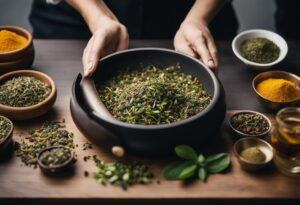
Tea blending techniques and recipes
There are several different techniques for blending tea, each with unique benefits. One popular method is “layering,” where different tea leaves are layered on each other to create a visually stunning blend.
Another technique is “mixing,” where the tea leaves are thoroughly mixed to create a uniform blend. Finally, there is the “infusion” method, where the tea leaves are combined with other ingredients and infused for a certain period to extract their flavors. Whichever method you choose, the key is to experiment and have fun with your tea blending.
In terms of recipes, the possibilities for tea blends are endless. Here is one simple recipe to get you started:
- English Breakfast Blend:
-
- 3 parts Assam black tea
- 2 parts Ceylon black tea
- 1 part Keemun black tea
To create this classic blend, mix the three types of tea leaves and store them in an airtight container. Adjust the ratio of each tea to suit your taste preferences. This blend is perfect for a hearty and robust tea to start your day.
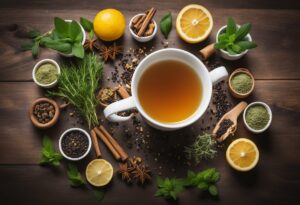
Brewing the perfect cup of tea
Now that your tea blend is ready, it’s time to brew the perfect cup of tea. Start by heating the water to the appropriate temperature for your chosen blend.
Place the tea leaves in a teapot or infuser and pour the hot water over them. Allow the tea to steep for the recommended time, usually between 2-5 minutes, depending on the type of tea.
Once the steeping time is complete, remove the tea leaves and pour the tea into your favorite teacup.
Take a moment to appreciate the aroma and color of the tea before taking your first sip.
With each sip, savor the flavors and let the tea transport you to tranquility and relaxation.
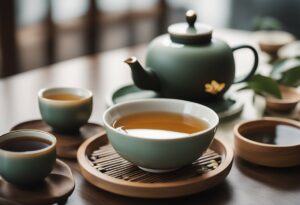
The art of tea tasting and appreciation
Tea tasting is a sensory experience that allows you to fully appreciate the nuances and complexities of different tea blends. It’s important to engage all of your senses when tasting tea.
Observe the color and clarity of the tea, inhale the aroma deeply, and take small sips to taste the flavors fully.
Notice the balance of sweetness, bitterness, and astringency, as well as any subtle notes that may be present. With practice, you will develop a discerning palate and be able to identify the unique characteristics of each tea blend.
The art of tea tasting is a lifelong journey of discovery and refinement.

Pairing tea blends with food and desserts
Tea is a beverage that can be enjoyed alone or paired with food and desserts to enhance the overall dining experience.
Just like wine, different teas have different flavor profiles that can complement a wide range of dishes.
For example, a light and floral green tea pairs well with delicate seafood or salads, while a robust black tea can stand up to rich and hearty dishes. When it comes to desserts, tea can provide a refreshing and aromatic contrast to sweet treats.
Experiment with different tea and food pairings to find combinations that harmonize and delight your taste buds.
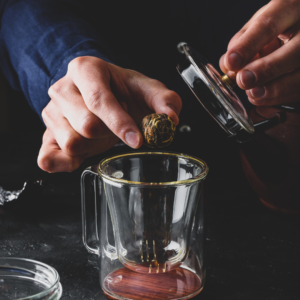
The health benefits of tea consumption
Beyond its delicious taste, tea also offers a myriad of health benefits. Tea is rich in antioxidants, which can help protect the body against damage from free radicals. It has been shown to boost the immune system, improve heart health, and reduce the risk of certain chronic diseases.
Additionally, tea contains compounds that have been found to promote relaxation and reduce stress. By incorporating tea into your daily routine, you can enjoy a delightful beverage and support your overall health and well-being.
Tea ceremonies and traditions around the world
Tea ceremonies have been an integral part of many cultures for centuries. From the elaborate Japanese tea ceremony to the casual British afternoon tea, each tradition has its rituals and customs.
These ceremonies provide a time for reflection, connection, and mindfulness. Whether participating in a formal tea ceremony or simply enjoying a cup with a friend, preparing and serving tea can be a meditative and calming experience. Take the time to appreciate the beauty and significance of tea ceremonies worldwide and find inspiration in their traditions.
Tips for storing and preserving tea blends
Proper storage is essential for preserving the freshness and flavor of your tea blends. To keep your tea at its best, store it in an airtight container away from heat, light, and moisture.
Avoid storing tea near strong-smelling substances, as tea can easily absorb odors. Labeling your tea containers with the date of purchase is also a good idea to ensure you’re using the freshest tea possible.
Lastly, be mindful of the shelf life of different teas, as some varieties may lose their flavor over time.
Following these simple tips, you can enjoy your tea blends at their peak freshness and flavor.
Exploring specialty tea shops and brands
While you can find tea in most grocery stores, exploring specialty tea shops and brands can open up a new world of tea flavors and experiences.
Specialty tea shops often offer a wide variety of high-quality teas from around the world and knowledgeable staff who can guide you in your tea exploration.
Many tea brands also have online stores, making discovering and purchasing unique tea blends easier than ever. Don’t be afraid to step outside your comfort zone and try teas you’ve never heard of before.
You may find a new favorite that will enrich your tea-drinking journey.
Conclusion
In conclusion, brewing and savoring exquisite tea blends is delightful and rewarding. From understanding the history and cultural significance of tea to exploring different types of tea and their characteristics, there is always something new to learn and discover.
By paying attention to water quality and temperature, selecting the right tea leaves for blending, and experimenting with different tea blending techniques and recipes, you can create unique and personalized tea blends that suit your taste preferences.
Brewing the perfect cup of tea, appreciating its flavors through tea tasting, and pairing it with food and desserts can elevate your tea-drinking experience to new heights.
Tea offers numerous health benefits and is deeply rooted in various tea ceremonies and traditions worldwide. By following tips for storing and preserving tea blends and exploring specialty tea shops and brands, you can continue to expand your tea knowledge and enrich your tea-drinking journey.
So, why not embark on this wonderful tea journey and discover the art of brewing and savoring exquisite tea blends for yourself?
Start your tea journey today by exploring different types of tea and experimenting with blending your unique tea creations. Share your favorite tea blends and brewing techniques with us in the comments below!
More From Tea Jubilee.
Exploring Exotic Ingredients In Tea Blends
The Top 10 Flavors To Mix In Teas
The Ultimate Guide To Herbal Tea Blends
Check out these other links too!
How to make cold brew iced tea
Benefits of drinking hot tea in the summer.
Rose and Earl Grey tea recipe.
And that’s all for today; thank you very much for reading my post about The Art Of Brewing Tea Blends! I am excited to hear what you think about this post.
I hope you sip on these tea blends and enjoy the day ahead, have a great weekend!


